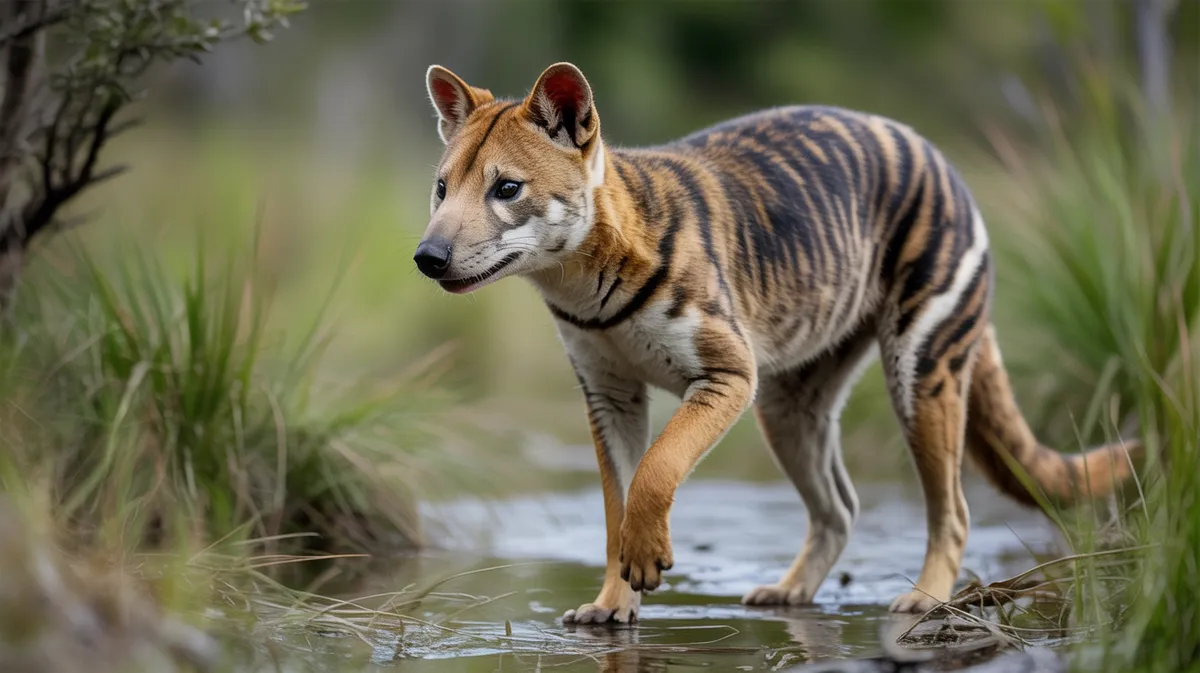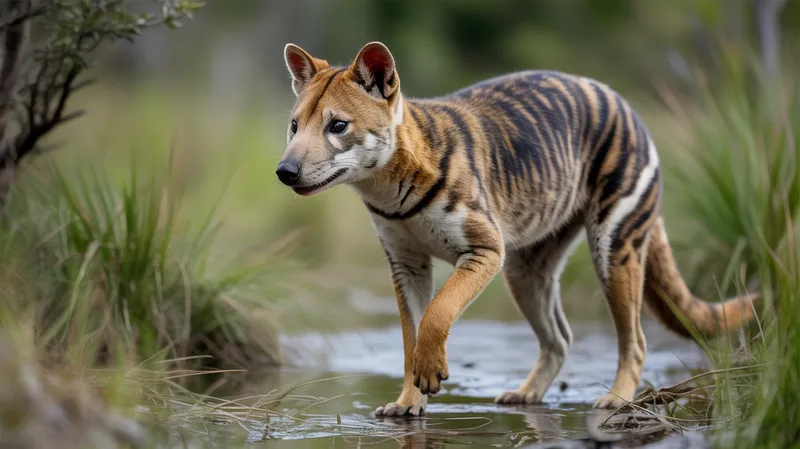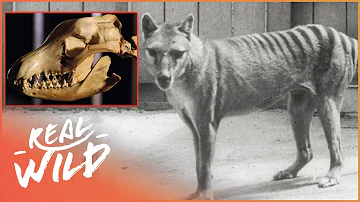
Thylacine
Thylacinus cynocephalus

Meet the Thylacine
The Thylacine, also known as the Tasmanian tiger or Tasmanian wolf, was a large carnivorous marsupial native to Tasmania, Australia, and New Guinea. It was characterized by its slender, dog-like body, stiff tail, and distinct dark stripes across its lower back and tail, which led to its 'tiger' nickname. The Thylacine was a nocturnal predator, hunting small to medium-sized animals and birds, and was known for its remarkable jaw, capable of opening to an unusually wide angle. Despite its wolf-like appearance, it was more closely related to kangaroos and koalas than to any placental mammal. The last known individual died in captivity in 1936, and the species is now considered extinct.
Classification
Mammal
Habitat
Forests, grasslands, and wetlands of Tasmania
Diet
Carnivore
Lifespan
5-7 years in the wild
Conservation
Extinct
Weight
15-30 kg
📖Fascinating Facts
Unique Jaw
The Thylacine's jaw could open to an extraordinary 80 degrees, allowing it to take large prey and deliver a powerful bite.
Striped Appearance
Its striking dark stripes on a sandy-brown coat earned it the nickname 'Tasmanian tiger,' despite having no relation to actual tigers.
Marsupial Predator
As a marsupial, the Thylacine carried its young in a pouch, a trait it shared with kangaroos and koalas, not with placental carnivores.
📋Detailed Description
The thylacine (Thylacinus cynocephalus) was the largest known carnivorous marsupial of modern times, measuring up to 180 cm (71 in) in total length, including a stiff, rod-like tail of about 50–65 cm (20–26 in), and standing roughly 60 cm (24 in) at the shoulder. Adults typically weighed between 15 and 30 kg (33–66 lbs), with males generally larger than females. Its fur was short and coarse, colored yellow-brown to gray with 13–21 distinctive dark stripes across the back and rump, which faded with age. The head was dog-like but with a broad, flattened skull and large, rounded ears, while the jaws were highly specialized, capable of opening to an angle of up to 80 degrees—one of the widest among mammals. The thylacine possessed 46 teeth, adapted for shearing flesh, and its hind legs were longer than the forelimbs, giving it a distinctive, stiff gait. The animal had a marsupial pouch, present in both sexes, with the female's pouch opening to the rear and the male's pouch protecting the scrotum. Thylacines were primarily nocturnal and crepuscular, with large eyes adapted for low-light hunting. Fossil evidence and historical accounts suggest it was a solitary or paired hunter, occupying a range of habitats from dense forests and wetlands to open grasslands across Tasmania and formerly mainland Australia and New Guinea.
💡 Did you know?
Unlike most marsupials, both male and female Thylacines had a pouch; the male's pouch protected its external reproductive organs.
🔬Research & Sources
Wikipedia Summary
The thylacine, also commonly known as the Tasmanian tiger or Tasmanian wolf, was a carnivorous marsupial that was native to the Australian mainland and the islands of Tasmania and New Guinea. The thylacine died out in New Guinea and mainland Australia around 3,600–3,200 years ago, prior to the arrival of Europeans, possibly because of the introduction of the dingo, whose earliest record dates to around the same time, but which never reached Tasmania. Prior to European settlement, around 5,000 remained in the wild on the island of Tasmania. Beginning in the nineteenth century, they were perceived as a threat to the livestock of farmers and bounty hunting was introduced. The last known of its species died in 1936 at Hobart Zoo in Tasmania. The thylacine is widespread in popular culture and is a cultural icon in Australia.
Last Modified: 6/3/2025
🎭Behavior & Social Structure
Thylacines were elusive and primarily nocturnal, emerging at dusk to hunt and patrol their territories. They were believed to be solitary or to form monogamous pairs, with little evidence of large social groups. Their hunting technique relied on stealth and endurance rather than speed, likely ambushing prey such as wallabies, small mammals, birds, and occasionally poultry or sheep. Thylacines had a slow, stiff-legged gait but could perform short bursts of speed. They marked territory with scent and vocalizations, including a series of yips, growls, and hisses. Resting during the day in dense vegetation or hollow logs, they were highly secretive and avoided human contact. Historical reports suggest they may have covered large home ranges, possibly up to 40–80 km², depending on prey availability.
👶Reproduction & Life Cycle
Breeding likely occurred in winter and spring (June–December), with females giving birth to litters of up to four young, though two was more typical. As marsupials, thylacine young were born highly altricial after a short gestation estimated at 30–36 days and continued development in the mother's rear-opening pouch for up to three months. After leaving the pouch, juveniles remained in a den or followed the mother, suckling for several more months. Both sexes had pouches, but only the female's was functional for rearing young. Sexual maturity was likely reached at about one year of age. Parental care was provided solely by the female, with no evidence of male involvement post-mating.
🛡️Adaptations & Survival
The thylacine's most notable adaptations included its powerful jaws and wide gape, allowing it to tackle prey larger than itself. Its cryptic coloration and stripes provided camouflage in dappled forest light. The stiff tail and elongated hind limbs aided in balance and endurance walking. Large, forward-facing eyes enhanced night vision. The rear-opening pouch protected young from debris while moving through dense undergrowth. As a marsupial predator, it filled an ecological niche similar to placental canids, a striking example of convergent evolution. Its dentition was specialized for slicing meat, and its metabolic rate was likely lower than placental carnivores, enabling survival in resource-scarce environments.
📚Research Sources
🎨Cultural Significance
The thylacine holds a prominent place in Australian and Tasmanian culture, symbolizing both the uniqueness of the region's fauna and the consequences of human-driven extinction. It appears in Aboriginal rock art and oral traditions, particularly in Tasmania and New Guinea. Since its extinction, the thylacine has become an icon of conservation, featuring in literature, art, and media. It is the official emblem of Tasmania and appears on the state's coat of arms and government insignia. The animal's image is widely used in campaigns for wildlife protection and has inspired numerous 'cryptid' searches and de-extinction debates.
🔬Recent Research & Discoveries
Recent research has focused on thylacine genetics, morphology, and ecology using preserved specimens and subfossil remains. Sequencing of mitochondrial and nuclear DNA has clarified its evolutionary relationships, confirming its closest living relatives are the numbat and Tasmanian devil. Studies of preserved pelts and skeletal material have refined understanding of its growth, sexual dimorphism, and disease susceptibility (notably, evidence of a distemper-like disease in late populations). Advances in imaging and 3D modeling have reconstructed its gait and bite mechanics, revealing adaptations for endurance rather than pursuit predation. Ongoing research explores the feasibility of de-extinction via genome editing, though practical and ethical challenges remain significant. The thylacine remains a focal point for studies of convergent evolution and extinction dynamics.
🎥Wildlife Videos

The Accidental Extinction Of The Tasmanian Tiger | Extinct Animals | Real Wild
The Tasmanian Tiger was first seen in 1930 on the coast of Australia. The Tasmanian Tiger was a supreme predator with the body ...
Real Wild

Why We're Not Sure How (And If) the Tasmanian Tiger Went Extinct
Images Courtesy of Getty Images Colourist of the thylacine footage: Samuel Francois-Steininger of Composite Films, France ...
Real Science

THYLACINE - Full history, Extinction, Sightings, De Extinction
In today's video, we explore the story of the Thylacine/Tasmanian Tiger/Tasmanian Wolf/Australian Hyena. From the evolution of ...
All.About.Nature

David Attenborough's | Tasmania | Weird and Wonderful
Attenborough narrates the story of a vast island wilderness - ancient forests, pristine rivers and spectacular coastline. Seasons ...
symmetry

Wildlife Expert Reviews Top 6 Tasmanian Tiger Sightings
Wildlife Expert Forrest Galante reviews the top 6 most famous extinct thylacine, or Tasmanian tiger, sightings ever caught on ...
Forrest Galante

Animal X Natural Mystery Unit - The Mystery of the Thylacine
The Thylacine, or Tasmanian Tiger, was declared official extinct in the late 1930s, but today people all over Australia claim to have ...
AnimalXTV mysteries and paranormal
🌍Habitat Information
The Thylacine typically inhabits Forests, grasslands, and wetlands of Tasmania environments. Thylacines have adapted to their environments with specialized features and behaviors.
Primary Habitat:
Forests, grasslands, and wetlands of Tasmania
More detailed habitat information will be available soon.
🛡️Conservation Status
The Thylacine is currently classified as Extinct. Conservation efforts are crucial for preserving this species for future generations.
Common Threats:
- 🏠Habitat loss and fragmentation
- 🌡️Climate change impacts
- 🎯Hunting and poaching
- 🏭Human-wildlife conflict
⚠️Threats & Conservation Challenges
The thylacine faced multiple threats leading to its extinction. On mainland Australia and New Guinea, it disappeared 3,200–3,600 years ago, likely due to competition with the introduced dingo and changing climate. In Tasmania, European colonization brought habitat loss, direct persecution, and disease. Bounties were paid for thylacine carcasses from the 1830s, resulting in mass killings. Livestock predation, whether real or exaggerated, fueled eradication campaigns. By the early 20th century, populations were critically low, and the last confirmed wild thylacine was killed in 1930. The final captive individual died in 1936 at Hobart Zoo. No verified sightings have occurred since, despite persistent unconfirmed reports. The species is listed as extinct by the IUCN.
🔬Scientific Classification
Scientific Name
Thylacinus cynocephalus
Classification Hierarchy
🔍 About Taxonomic Classification
Taxonomic classification is a hierarchical system used by scientists to classify and organize living organisms based on shared characteristics and evolutionary relationships.
The system moves from broad categories (Kingdom) to increasingly specific ones, with each animal's scientific name typically consisting of its Genus and species.
📝Community Notes
Share your observations and insights about the Thylacine with our community of wildlife enthusiasts.
Join Our Community
Sign in to share your observations and connect with fellow wildlife enthusiasts.
Sign In to ContributeNo community notes yet
Be the first to share your observations about the Thylacine!
Explore Thylacine
Select a tab above to learn more about this amazing animal.
📸Photo Gallery
No photos available for this animal yet.
🌟Discover More Wildlife
Continue your journey of discovery with more fascinating animals from our database
